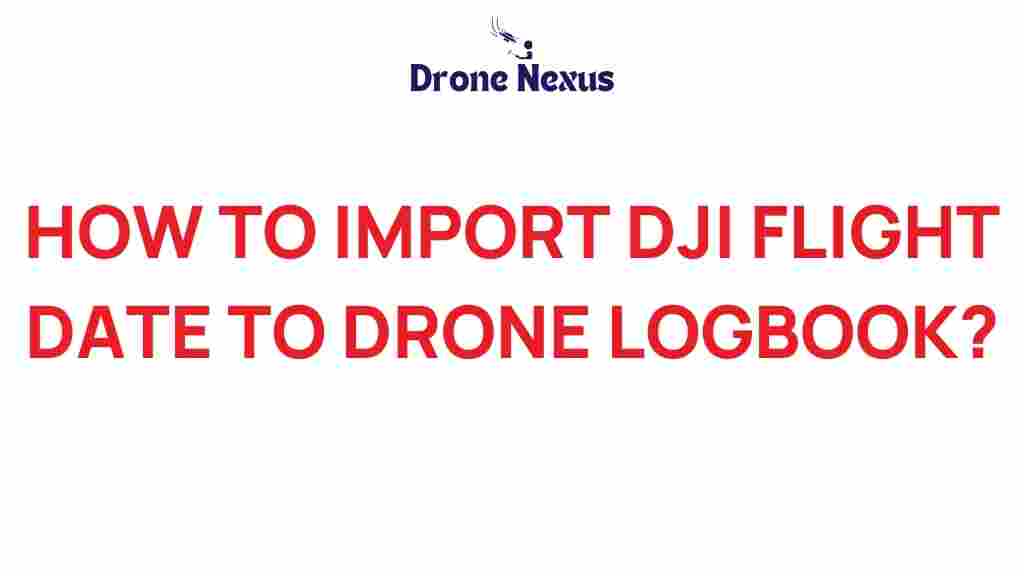Unlocking the Skies: How to Import DJI Flight Data into Your Drone Logbook
In the world of drone flying, keeping track of your flights is essential. Not only does it help you improve your skills, but it also aids in maintaining your drone and complying with regulations. One of the most effective ways to log your flights is by importing DJI flight data into a digital logbook. In this comprehensive guide, we will explore how to import DJI flight data into your drone logbook, ensuring you have a complete flight history at your fingertips.
Understanding DJI Flight Data
Before diving into the import process, it’s crucial to understand what DJI flight data entails. This data includes various metrics such as:
- Flight time
- Distance flown
- Altitude
- Battery usage
- GPS coordinates
- Flight modes
This information not only helps in personal tracking but also provides insights into the drone’s performance, making it easier to manage maintenance schedules and compliance with regulations.
Step-by-Step Process to Import DJI Flight Data
Now that we understand the significance of DJI flight data, let’s look at how to import this data into your drone logbook. The process can vary slightly depending on the logbook software you choose, but the general steps remain the same.
Step 1: Collecting Your DJI Flight Data
To start, you need to gather your DJI flight data. You can do this through the DJI app (like DJI GO or DJI Fly) on your smartphone or tablet. Here’s how:
- Open the DJI app.
- Connect your drone and power it on.
- Navigate to the flight records section.
- Select the flights you want to export.
- Choose the option to export or share your flight data.
- Save the data as a .csv or .txt file on your device.
Step 2: Choosing Your Drone Logbook Software
Next, you need to select a suitable drone logbook software. Some popular options include:
Make sure to choose a logbook that supports importing DJI flight data.
Step 3: Importing the Data into Your Logbook
Once you have your flight data collected and your logbook software selected, follow these steps to import your DJI flight data:
- Log in to your drone logbook account.
- Navigate to the import or upload section of the software.
- Select the file you exported from the DJI app.
- Follow any prompts to map the data fields correctly.
- Confirm the import and check for any errors.
After completing these steps, your DJI flight data should be successfully imported into your logbook!
Step 4: Reviewing Your Flight Data
Once your data is imported, take some time to review it. Look for:
- Accuracy of flight times
- Battery performance records
- Flight paths and distances
This review process helps you ensure the integrity of your flight data and identify any discrepancies that may need correction.
Troubleshooting Common Issues
Even with a well-laid plan, you may encounter some common issues while importing DJI flight data. Here are some troubleshooting tips:
Data Not Importing Correctly
If your DJI flight data isn’t importing correctly, check the following:
- Ensure the file format is supported (.csv or .txt).
- Check for any missing fields in your data file.
- Make sure you have a stable internet connection.
Inaccurate Data Displayed
If the data appears to be inaccurate after importing, consider these steps:
- Verify the original data in the DJI app.
- Check the data mapping in your logbook software.
- Consult your logbook’s user guide for data formatting requirements.
App Crashes or Freezes
If the DJI app crashes while exporting flight data, try:
- Restarting your device.
- Updating the app to the latest version.
- Clearing the app cache (for Android users).
Conclusion
Importing DJI flight data into your drone logbook is a straightforward process that can enhance your flying experience. By following the steps outlined in this guide, you can efficiently track your flight history, monitor performance, and ensure compliance with regulations. Remember to regularly review your data and update your logbook for the best results.
With your flight data securely logged, you can focus on what you love most—flying and exploring the skies!
For more tips and tricks on drone flying, check out our comprehensive guide on drone maintenance and safety.
This article is in the category Applications and created by DroneNexus Team
